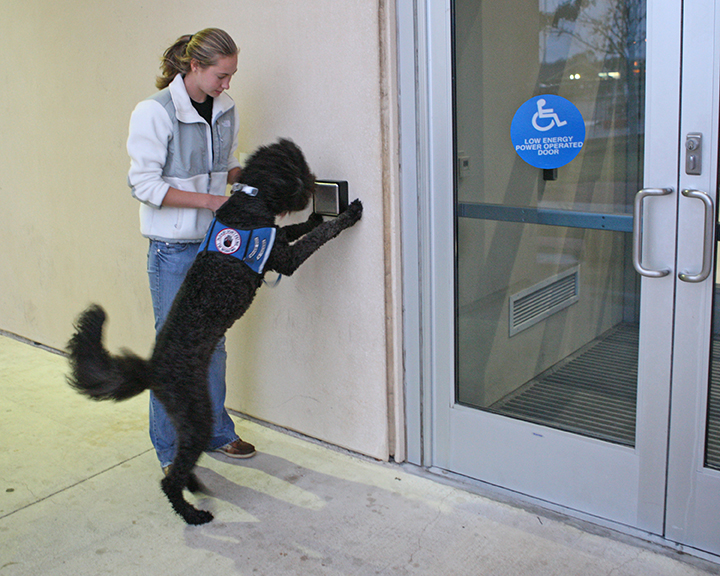Assisting Service Dogs
Although most people have pets strictly for companionship, those with disabilities often use animals to help perform every day functions. These “service animals” are trained to provide specific assistance tailored to their owner’s disability. Just like any animal, however, service animals can develop disabilities and need rehabilitation as well.

There are multiple types of service animals. For example, miniature horses are trained as guides for those who are visually impaired or in need of mobility assistance. Even Capuchin monkeys can be trained to help with daily tasks that require grasping and manual dexterity. Dogs, however, remain the most common service animal. Service dogs are generally either rescued from shelters or bred in specific breeding programs. Although there is not a specific breed requirement for service dogs, most tend to be golden retrievers or labrador retrievers. One of the main determining factors for service dogs is size because they are expected to perform physical activities. Thus, most assistance dogs are of medium to large size.
While these special dogs are trained to provide a variety of tasks, the two most common jobs performed by service dogs are guiding the visually impaired or offering mobile support for the owner. Some service dogs can also be trained to pick up objects, open doors, or operate light switches. In recent years, service dogs have even been trained to help those with autism, low blood sugar, and psychiatric disability. Amazingly, service dogs have been able to alert an epileptic person minutes, or even hours, before seizures.
Dr. Jacqueline Davidson, clinical professor at Texas A&M College of Veterinary Medicine & Biomedical Sciences’ (CVM) Small Animal Hospital, said prior to dogs joining a service training program, they are screened for potential problems to ensure they are healthy enough to complete their duties.
“Generally, they are evaluated for congenital conditions, particularly relating to their vision or hearing,” Davidson said. “In addition, dogs that are of medium or large breeds are evaluated for dysplasia of the hips and elbows. Joints may also be checked for other developmental diseases that could cause problems later in life.”
Davidson explained that this screening process means that dogs trained as service animals are probably less likely to develop certain orthopedic problems as compared to those of the general population that are not always tested for these things. She said that there have been no reported health risks directly related to service animals, but, as with companion animals, they can still develop health problems over time. If a service dog does develop a disability, through proper treatment the dog will be able to continue to serve.
“We occasionally treat a service dog that has developed a disability,” Davidson said. “But they often return to work after physical rehabilitation.”
Rehabilitation is important with any animal, but Davidson said it can be a crucial factor in the recovery of working dogs. She explained that since service animals require a certain level of physical ability to perform their jobs, they are expected to return to a higher level of function after surgery and rehabilitation than the average companion dog.
“Since service dogs have so many responsibilities, it’s important they make a full recovery before returning back to work,” Davidson, a Diplomate of the American College of Veterinary Sports Medicine and Rehabilitation, said.
The American College of Veterinary Sports Medicine and Rehabilitation (ACVSMR) is a specialty recognized by the American Veterinary Medical Association, created to encourage veterinary expertise in the “structural, physiological, medical, and surgical” needs of service, working, and athletic animals.
The dedication of the new college by the AVMA shows the importance placed on having experts in the field of rehabilitation for service animals. When service dogs are hurt, they cannot fulfill their jobs. Through proper rehabilitation, however, the dogs can continue to serve their owners.
Pet Talk is a service of the College of Veterinary Medicine & Biomedical Sciences, Texas A&M University. Stories can be viewed on the Web at vetmed.tamu.edu/news/pet-talk. Suggestions for future topics may be directed to editor@cvm.tamu.edu.


